A vertical branding strategy pushes for objectively better products, while horizontal branding strategy is okay with being different.
When I do brand strategy consulting, I often hear from the business owners and executives talk about the measures on which their product is the best in the marketplace. Having the best product is an accomplishment, but staying the best is a long hard road. Sometimes it’s better to be different.
That is the core of the argument of vertical branding vs. horizontal branding. Do you differentiate your brand as better or different?
Vertical branding is when a company differentiates itself as “better” on an objective scale, such as miles-per-gallon, megapixels, etc.
For example, Hyundai chose a vertical brand strategy for its IONIQ hybrid car touting it as “the most fuel-efficient car in America” with it’s 58 combined mpg.
Horizontal branding is when a company differentiates its product as “different” and subjectively more appealing to some people.
For example, the MINI car brand is an example of a horizontally differentiated brand. MINI plays up it’s fun and quirky perception to appeal to stylish people.
These strategies are not mutually exclusive. Most companies start with a vertical brand strategy when they are a startup and move to a horizontal brand strategy when they establish the market.
Vertical Branding Strategy
Vertical differentiation or a vertical branding strategy is when a brand differentiates its product as “better.”
A company with a vertical brand strategy utilizes a technology, material, structure, or process that makes the product better in some objective measurement. Examples of these objective measurements include horsepower, gigahertz, miles per gallon, cost per acquisition, server response time, etc.
For example, Nikon’s Z7 features a sensor capable of 64 to 25,600 ISO. A camera’s sensitivity, or ISO, is an objective measure of performance in low light, regardless of other subjective features of the camera, like position and feel of the buttons. Nikon’s approach contrasts against GoPro who does not care about having the product with the best ISO.
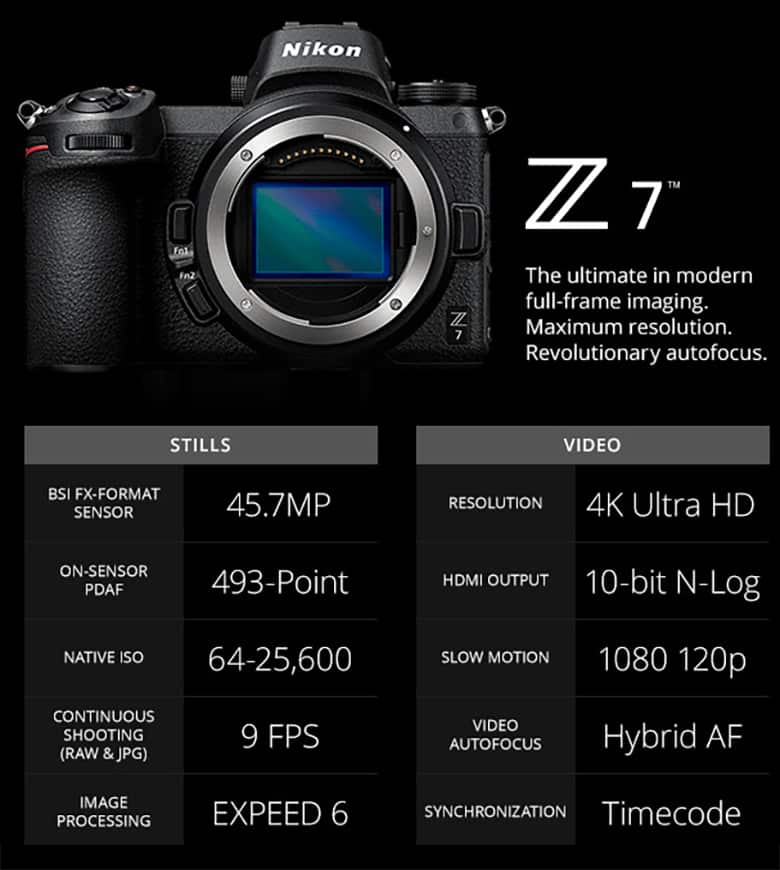
Advantages
Simple sales proposition. Displaying a stat and noting that it is the best in the market is the simplest way of differentiating a product.
Free promotion in media. Often trade magazines and websites will write about the latest and greatest. The media coverage is free promotion.
Halo effect on other products in the brand’s portfolio. When one product is “the best,” people will look at the other products offered as “better” too, whether they are or are not.
Disadvantages
Hard to maintain. Competitors may release products that beat the brand’s product, and the sales advantage evaporates overnight.
Never a permanent strategy. A company cannot be the best forever, so brands need to think about “phase two” after they are de-throned.
A product may be the best on a feature customers do not care about. Often objective measures do not translate to better customer experiences. Sometimes no one cares about the stat a brand is promoting.
Examples of Vertical Branding
Hyundai IONIQ hybrid car having 4.2 city/4.0 highway/4.1 combined fuel economy making it the most fuel-efficient vehicle available.
AMD’s Ryzen Threadripper CPU is the worlds most powerful desktop processor with 32 cores at 4.2 GHz each.
Verizon FIOS is offering 940 Mbps internet download speed.
Horizontal Branding Strategy
Horizontal differentiation or a horizontal branding strategy is where a brand differentiates its product as “different.”
A company with a horizontal brand strategy uses design, engineering, and marketing to make their product uniquely appealing to the needs of certain types of people. There is no objective way to rank their product; some people will like them; others will not.
For example, GoPro made a rugged camera. Ruggedness is a subjective measure; it depends on the person whether they would define a rugged camera as a better camera. An action sports enthusiast will appreciate a tough GoPro, while a portrait photographer wouldn’t. That photographer might prefer the Nikon with the high ISO we talked about before.
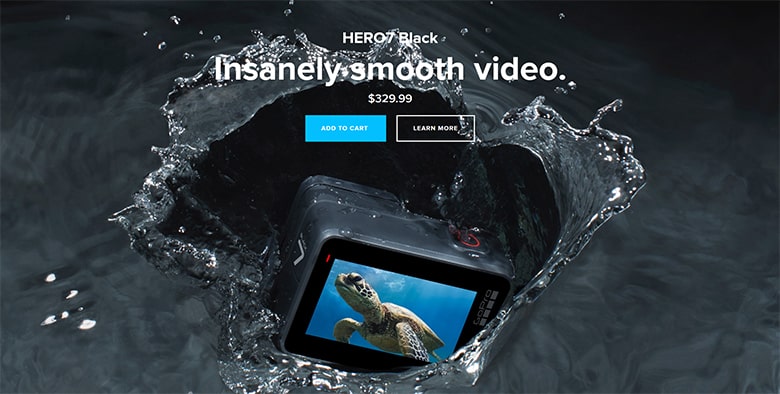
Advantages
Customer loyalty. People will be loyal to a brand that makes products specifically tailored to their needs. Not only are they better served, but the brand also expresses who they are.
Market less sensitive to price. Customers don’t compare prices when they feel like one brand uniquely serves them.
Defensible position. While maintaining a technical advantage can be impossible, staking out a unique value proposition can be maintained for decades.
Disadvantage
Horizontal branding requires media spending. A brand needs to promote the brand personality and vision they are going for.
Subject to ups and downs of the category. If the lifestyle wains in popularity, the brand’s sales will too. For example, DC Shoes sells less merchandise when skateboarding is less prevalent. (Read our article about the history of DC Shoes.)
Consumer tastes change. Fads die off, and lifestyles change. If a brand’s demand is tied to one of these, then sales may go down if tastes change.
Demographics will force you to change. If a horizontal brand is lucky enough to have a long term appeal, then demographics will force it to rebrand eventually. People will age out of the market.
Examples
Beats by Dre headphones have a bass-rich sound.
MINI makes a quirky and fun small car.
Quiksilver makes apparel for people who connect with the surfer lifestyle.
Visualizing the difference
You can visualize the difference between vertical branding and horizontal branding as cartesian access (see below).
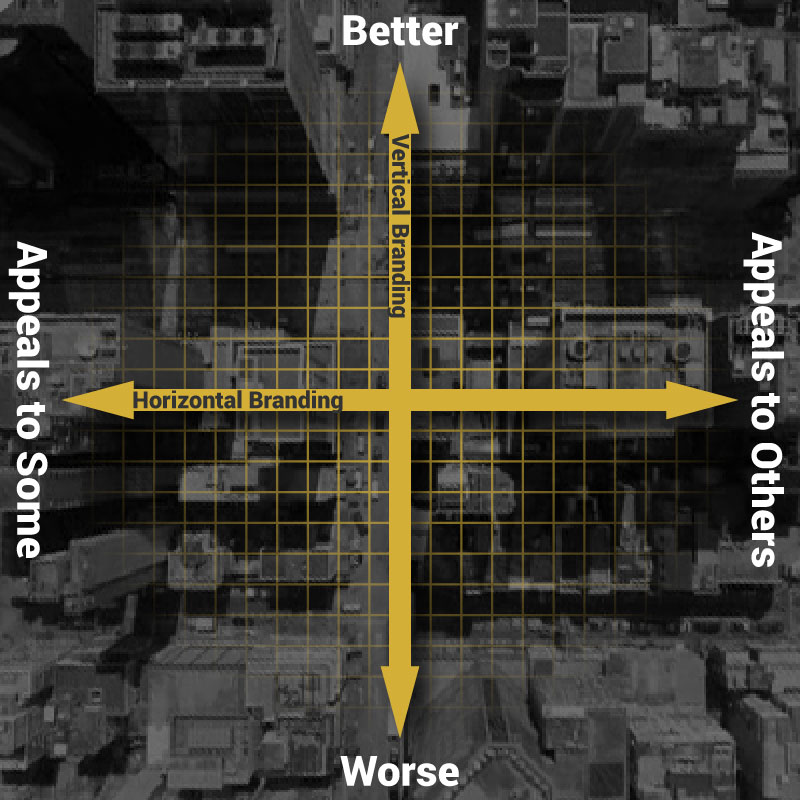
The vertical access, i.e., the y-axis, is the objective scale, measures like price, horsepower, megapixels, etc. The horizontal axis, i.e., the x-axis, is for taste or preference. Some people may like something on the right side, and other people may want something from the left side.
You can use this grid as a way of assessing the marketplace. You can graph each brand’s product in a category against an objective measure, and then sort them on a taste continuum. Sometimes this analysis can reveal a hole in the market that a brand can retool their product and messaging to fill.
For example, I have plotted the electric cars currently available to the North American market on a graph. On the y-axis is the range of the top trim line, which is an entirely objective measure. On the x-axis, I have a continuum between sporty and utilitarian. This characterization of the automotive design of each model is subjective, but I tried to place them in a way most people would agree with.
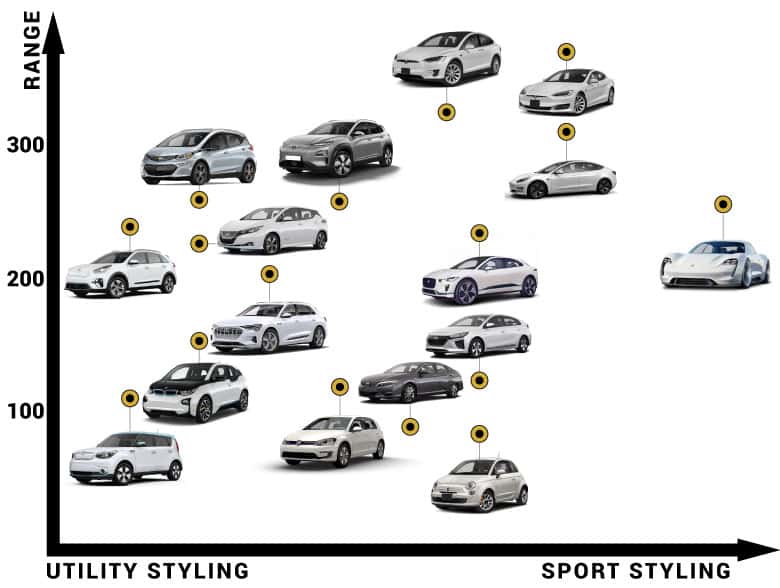
Looking at this graph, you can see how crowded the utility styling side of the market is. If you are a company like Mazda, who plans to enter the market, it makes sense to have a sportier styled car. An electric version of the Mazda MX-5 would be a very differentiated product.
Not mutually exclusive
Vertical branding and horizontal branding are not mutually exclusive. Many products have high-performance measures that they promote, but also subjective aspects that they also mention.
Historically, most brands have followed an upside-down “L” pattern on the axis above. A startup company makes a product with better technology and shouts that advantage from the rooftops. When the brand establishes it’s reputation in the marketplace, and their competitors have caught up, they pivot to a horizontal brand strategy and make themselves different while still trying to be better.
For example, early Apple came out with the first color personal computer, but they quickly moved into a strategy of appealing specifically to creative professionals.
Also, Dyson had an indisputable product advantage, the canister vacuum while their competitors had bags, that quickly disrupted the market. Fast forward ten years and their competitors had all switched to variations on the canister vacuum, but Dyson has grown beyond just a better vacuum company. They are now a brand synonymous with design and quality, more subjective measures.
We talk about Dyson more in our examples of brand extensions article. You won’t believe what product category Dyson just moved into.
Conclusion
Don’t worry if your product isn’t the best; being different is a valid brand-building strategy.
So many striving companies lose their motivation because they do not have the best product in their category. Many small businesses look to large competitors and are discouraged because they do not have the resources to develop a superior product to them.
However, many brands are not selling an objectively a better product. Instead, they focus on making a different product that serves the unique needs of a different set of people.
GoPro has never made a camera with the best megapixels or low-light performance. However, they made a uniquely durable camera that revealed a whole new market: action cameras. It turns out that there are a ton of action sports enthusiasts eager to make films featuring their death-defying adventures. It’s not objectively the best product for everybody, but some people love it.
References
Vertical branding according to brandUNIQ
Forbes: Vertical Brands Crash. Horizontal Brands Fly. All You Have To Do Is Ask.
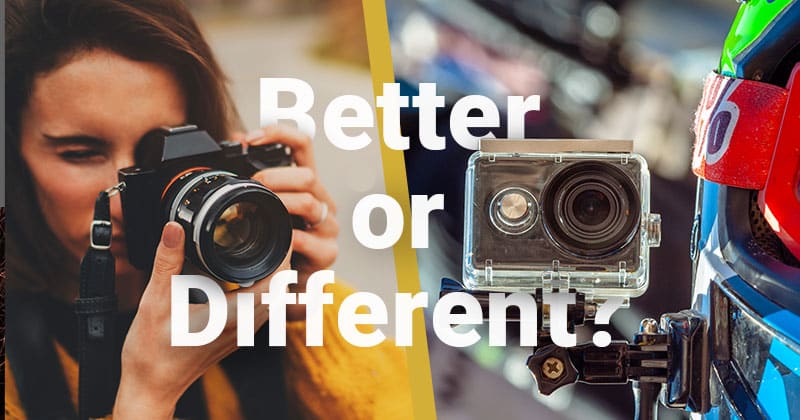
Leave a Reply